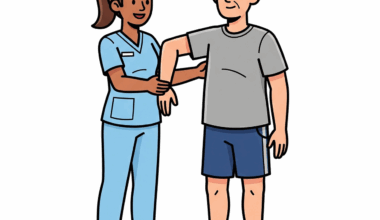Role of Cross-Training in Enhancing Triathlon Recovery
Triathlon training consists of extensive physical effort in swimming, biking, and running, which places considerable strain on the body. Recovery techniques are crucial in helping athletes regain strength and prevent injuries. Cross-training serves an essential function by incorporating varied workouts that help enhance recovery. Engaging in different activities, such as cycling or yoga, can relieve tightness and stimulate blood flow to sore muscles. This not only promotes recovery but also aids in maintaining overall fitness without pressuring the body to adapt to one single form of exercise. Cross-training can prevent overuse injuries due to repetitive motions, creating a solid base for triathletes. Activities like cycling provide low-impact alternatives that allow athletes to keep training while their muscles recover from high-intensity runs. Utilizing specific cross-training techniques can diversify strength training by focusing on different muscle groups that are not primarily engaged in traditional triathlon events. Moreover, mental recovery from training fatigue is equally vital, and varied workout routines can keep athletes motivated. Staying engaged in alternative activities helps to ensure enthusiasm for training is sustained during recovery periods.
Types of Cross-Training Activities
There are several effective cross-training activities that triathletes can adopt to enhance their recovery. Each type targets different muscle groups, allowing diverse stimuli for recovery. Swimming is a low-impact option that promotes cardiovascular strength without stressing the joints, making it ideal after hard runs. Alternatively, cycling also delivers significant health benefits; it builds leg strength while reducing the weight on legs, which is crucial for recovery. Yoga and pilates are excellent for enhancing flexibility, promoting muscle relaxation and balance. They can significantly reduce muscle tightness while improving mobility. Resistance training, when included strategically, can augment strength and endurance across all three triathlon disciplines. Circuit training, incorporating various exercises targeting multiple muscle groups, can increase heart rate and improve aerobic capacities while promoting muscle synthesis. Additionally, incorporating more recreational activities like hiking or dancing can enhance overall well-being and recovery without the usual training pressures. Diversifying the workout regimen can prevent burnout and staleness often associated with repetitive training schedules. Ultimately, various cross-training activities lead to long-term benefits in performance, improving athletes’ ability to complete training cycles effectively.
Specific strategies for integrating cross-training into a triathlon recovery routine can maximize effectiveness. One effective approach includes scheduling recovery days dedicated solely to cross-training activities. Athletes must allow their bodies to recuperate fully while still maintaining some level of cardio conditioning. Implementing low-intensity sessions, such as swimming sessions or yoga stretches, can provide both physical and mental breaks from primary training. It is also essential to listen to the body’s signals; should fatigue persist, athletes must consider modifying workout intensity. Creating a monthly training calendar that distinguishes primary workouts from cross-training days can enhance organization and clarity. Moreover, participating in group classes or team activities can elevate motivation levels in recovery periods while facilitating social interactions. Tracking progress in cross-training sessions can help athletes identify which activities yield the most benefits. Competitive athletes can also consider varying between aerobic and anaerobic conditioning sessions to enhance muscle recovery during the overall training cycle. Ultimately, a strategic cross-training approach can lead to improved performance on race day by ensuring the body adapts smoothly and effectively to intense training phases.
Benefits of Cross-Training for Recovery
The benefits of cross-training during recovery can be substantial, influencing both physical and mental aspects of athletic performance. Physically, alternate training routes can enhance muscle recovery through varied exertion levels, allowing for targeted rest of specific muscle groups while keeping the cardiovascular system active. Cross-training creates opportunities for reduced injury risks by engaging in low-impact exercises, decreasing the likelihood of overuse that is common with high-intensity triathlon training. This technique can broaden muscle flexibility and range of movement. From a psychological standpoint, cross-training can retain the athlete’s motivation, as varied workouts are often more enjoyable than repetitive routines. This boost in mental positivity can lead to better attitudes towards overall training. Plus, many athletes report feelings of rejuvenation when introducing cross-training programs, as these help foster a better emotional connection to their physical training. Bringing variety can lead to a deeper appreciation for their sport, leading athletes to discover new skills and interests. All these benefits combined can work harmoniously to ensure that a triathlete remains enthusiastic and committed, ultimately improving performance when race day arrives.
Understanding proper post-workout recovery techniques is vital for triathletes. Stretching, hydration, and nutrition play significant roles in optimizing overall recovery processes. After cross-training sessions, performing gentle stretches can alleviate tight muscles, ultimately enhancing flexibility. Hydration remains pivotal; sipping water and replenishing electrolytes can restore fluids lost during training. Incorporating proteins and carbohydrates into recovery meals ensures muscles receive necessary nutrients for rebuiling and growth. Furthermore, utilizing foam rollers post-exercise can have profound benefits, aiding in breaking down muscle knots and enhancing blood flow. Engaging in mindfulness practices, including meditation, can promote mental recovery and overall well-being. Additionally, athletes should consider adequate sleep as a core recovery strategy; sleep is a powerful rehabilitative tool that influences recovery times immensely. Quality sleep improves muscle repair, hormonal balance, and cognitive function. Personalization of recovery techniques based on individual needs can heighten benefits. Every athlete’s body reacts uniquely to stress, and understanding personalized recovery rhythms through trial and error can yield optimal results. Ultimately, implementing targeted recovery practices can create a much more seamless transition between hard training and recovery efforts, leading significantly towards better performance.
Implementing a Holistic Recovery Plan
Creating a holistic recovery plan integrating cross-training is paramount for triathletes committed to optimal performance. Athletes can begin by assessing their current training loads, gradually integrating cross-training throughout the week. Setting achievable weekly goals helps streamline this process, allowing for celebration of accomplishments while keeping sight of overarching objectives. Triathletes can utilize tools such as fitness trackers to monitor performance, ensuring alignment with set goals. Balancing the right amount of intensity in cross-training with necessary recovery days determines the pacing of an effective plan. Additionally, involving sports nutritionists can provide tailored dietary needs to further enhance recovery protocols. Recovery supplements, including amino acids or protein powders, can contribute effectively when timed correctly post-workout. Regular consultations with physiotherapists can also promote injury prevention strategies throughout triathlon training. Incorporating mental health days for purely restorative activities such as hiking or nature walks can promote emotional recovery. Such holistic approaches empower athletes to perform consistently at their best while minimizing downtime associated with excessive training. Overall, a well-structured recovery plan can sustain enthusiasm throughout the training cycle.
In conclusion, cross-training serves as a vital component within triathlon recovery techniques. By diversifying workout routines, triathletes can improve physical recuperation while fostering mental resilience. Introducing varied training modalities reduces the risks of injuries, enhances overall muscle flexibility, and strengthens the cardiovascular system, all critical aspects of an athlete’s performance. Additionally, effective recovery isn’t isolated merely to physical considerations; mental health and motivation towards training are equally crucial facets to consider. Triathletes must remain attentive to their bodies and plan appropriate cross-training activities effectively while ensuring proper recovery techniques. The integration of cross-training can ultimately lead to higher levels of competitiveness, as an athlete possessing solid recovery strategies will likely outperform those who neglect this aspect of their training. Engaging in cross-training activities can introduce fun and engagement into the recovery process while enhancing physical capacities. Making informed decisions regarding recovery protocols lays groundwork conducive to race day success. By bridging together physical and mental recovery pathways through cross-training, triathletes can cultivate the resilience necessary for enduring rigorous training protocols, ultimately achieving their athletic aspirations.


